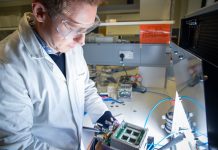
In a pivotal development, researchers from Northwestern University unveil a groundbreaking technique for carbon capture from ambient environmental conditions, leveraging the relationship between water and carbon dioxide and introducing the “moisture-swing” methodology.
Harnessing Humidity for Carbon Capture
Unlike traditional carbon capture approaches that focus on point-of-source locations, Direct Air Capture (DAC) serves to capture CO2 from general environmental conditions.
The “moisture-swing” technique is innovative in that it captures CO2 at low humidities and releases it at high humidities.
This approach is particularly compelling as it employs kinetic methodologies and a variety of ions, facilitating carbon removal from virtually any location.
The study, published in the journal Environmental Science & Technology, represents a stride towards optimizing and expanding ion choices for carbon capture, shedding light on complex fluid-surface interactions.
It aims to deepen collective understanding of DAC, providing invaluable data that could steer the scientific community towards refining carbon capture in practical scenarios.
The Appeal of Moisture-Swing Carbon Capture
Benjamin Shindel, one of the paper’s co-first authors, expressed the team’s interest in utilizing ambient environmental conditions to enable the reaction, stating that moisture-swing carbon capture is captivating because it doesn’t have a defined energy cost.
Ideally, energy could be saved by utilizing environments with natural dry and wet air reservoirs, mitigating the energy otherwise needed to humidify a volume of air.
Moreover, the researchers managed to not only double the number of ions that facilitate the desired humidity-dependent carbon capture but also identified the highest-performing systems to date.
Comparing Traditional and Moisture-Swing Carbon Capture
Traditional carbon capture methodologies deploy sorbents to capture CO2 at specific sources and typically require significant energy, often through heat or generated vacuums, to release CO2 from the sorbent.
In contrast, moisture-swing carbon capture is not tightly bound to CO2, which reduces the energy needed to release and reuse it.
This comes as a beneficial alternative, especially for industries like agriculture and manufacturing (e.g., concrete and steel), which are major emission contributors but have expansive footprints that thwart single-source carbon capture.
Future Directions and Global Implications
With an eye towards future endeavors, the researchers anticipate that combining experiments and computational modeling will furnish clearer insights into why certain ions are more effective than others in this application.
The team also plans to amalgamate CO2 capturing materials with a previously developed porous sponge platform, aimed at removing various environmental toxins, including phosphates, microplastics, and oil.
In a global context, as wealthier nations stride towards achieving below zero emissions, developing countries may gradually diminish CO2 production, especially those more anchored in the carbon economy.
DAC, especially with the novel approach of utilizing ambient environmental conditions, holds promise in being an integral tool in the combat against climate change, mitigating atmospheric CO2 concentrations, and moving towards a decarbonized future.
This new approach to DAC heralds not only a novel methodology but also widens the horizons of scalable, energetically favorable carbon capture from the atmosphere, underscoring a vital step towards sequestering existing atmospheric CO2 and making tangible progress in the battle against climate change.
The research findings can be found in Environmental Science & Technology.
Follow us on Twitter for more articles about this topic.



